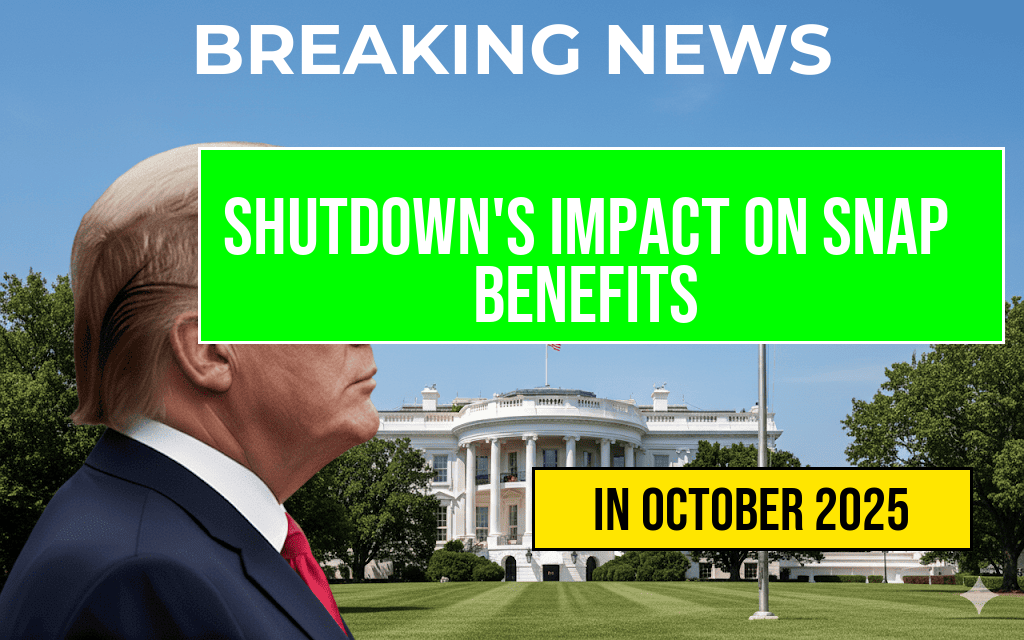The looming threat of a government shutdown could significantly disrupt Supplemental Nutrition Assistance Program (SNAP) benefits and other federal food assistance initiatives. If Congress fails to pass funding legislation before the deadline, millions of Americans relying on these programs may face delays or reductions in their monthly benefits. Unlike typical policy debates, a shutdown directly affects the operational capacity of federal agencies responsible for distributing nutrition aid, raising concerns among advocacy groups and recipients alike. This article explores how a potential shutdown might impact SNAP benefits, the broader food assistance landscape, and what affected individuals and communities can expect during this uncertain period.
Potential Disruptions to SNAP and Food Assistance Programs
SNAP, formerly known as food stamps, serves approximately 42 million Americans, including children, seniors, and people with disabilities. The program is administered by the U.S. Department of Agriculture (USDA), which relies on federal funding to operate smoothly. In the event of a shutdown, the USDA’s capacity to process benefit distributions could be hampered, leading to delays in issuing benefits or partial payments for recipients. Historically, during shutdowns, the USDA has managed to continue providing benefits through contingency plans, but prolonged closures threaten the stability of this support system.
Funding and Administrative Challenges
- Benefit issuance delays: Without appropriated funds, there could be delays in processing new applications and re-certifications, potentially leaving some recipients without benefits for a period.
- Impact on state agencies: State agencies responsible for managing SNAP may face staffing shortages or operational constraints, further complicating benefit distribution.
- Emergency measures: The USDA has occasionally declared that benefits scheduled to be issued before a shutdown will continue, but future payments may be uncertain without congressional funding.
Temporary Assistance and Food Programs at Risk
Beyond SNAP, other federal food aid programs such as the Special Supplemental Nutrition Program for Women, Infants, and Children (WIC) and school meal programs may also experience disruptions. While some programs have dedicated funding sources that could sustain operations temporarily, extended shutdowns could lead to reduced access or eligibility issues for vulnerable populations.
Impact on Vulnerable Populations
Individuals and families relying on food assistance programs are particularly vulnerable during a government shutdown. Food insecurity levels could rise, especially among low-income households already struggling to meet basic needs. Food banks and community organizations often buffer some of these impacts, but their resources are finite and often stretched thin during economic downturns or crises.
Immediate Effects on Recipients
| Timeframe | Expected Impact |
|---|---|
| Within Days | Possible delays in benefit processing; some recipients may see benefits temporarily unavailable. |
| One to Two Weeks | Extended delays could lead to food shortages for vulnerable households; increased reliance on emergency aid. |
| Beyond Two Weeks | Risk of benefit reductions or suspension of certain programs if funding remains unavailable. |
Economic and Health Consequences
Food insecurity has well-documented links to negative health outcomes, including malnutrition and increased hospitalization rates. During a shutdown, these risks may escalate as families are forced to make difficult choices between paying for food and other essentials. Additionally, local economies could face ripple effects, with decreased demand for food retail and service businesses in communities heavily dependent on SNAP recipients.
Policy Responses and Contingency Plans
Federal agencies have occasionally preempted some shutdown effects by maintaining essential services or drawing from contingency funds. For SNAP, the USDA has historically issued benefits ahead of scheduled dates to mitigate immediate hardship. Congress can also pass short-term funding extensions to prevent disruptions, but political disagreements often complicate such efforts.
State-Level Interventions
States may implement their own measures to cushion the blow, such as advancing benefits or providing supplemental support through state-funded programs. However, these measures are limited in scope and depend heavily on state budgets and resources.
What Recipients and Advocates Can Do
Individuals affected by potential SNAP disruptions are encouraged to stay informed through official channels such as the USDA or local social service agencies. Preparing for possible delays by budgeting resources or seeking assistance from community organizations can help mitigate immediate hardships. Advocacy groups continue to press for Congress to prioritize funding for food assistance programs, emphasizing the importance of maintaining support for vulnerable populations during political impasses.
For more information on SNAP and federal food programs, visit the USDA’s official site at https://www.fns.usda.gov/snap.
Additional insights on government shutdown impacts can be found at Wikipedia’s page on U.S. government shutdowns.
Frequently Asked Questions
What is the expected impact of the government shutdown on SNAP benefits?
The government shutdown may temporarily disrupt the distribution of SNAP benefits, potentially causing delays in benefit issuance for recipients until federal funding is restored.
Will food assistance programs continue during a government shutdown?
Some food assistance programs may experience disruptions or reduced services during a government shutdown, depending on federal funding allocations and agency operations.
How long could the government shutdown last before affecting SNAP and food programs?
The duration of the government shutdown directly influences its impact on SNAP and food assistance programs. Short-term shutdowns may cause minimal disruptions, while extended shutdowns could significantly affect benefits and services.
Are there any steps recipients can take to prepare for potential disruptions?
Recipients are advised to review their benefit balances and plan accordingly. It’s also helpful to stay informed through official government communications and local food assistance offices for updates.
What resources are available for those affected by the shutdown’s impact on food assistance?
Individuals impacted can reach out to local food banks, community organizations, and state agencies for emergency support and information about alternative resources during the government shutdown.

Leave a Reply